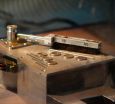(Press-News.org) A new twin study from the Norwegian Institute of Public Health shows that the heritability of avoidant and dependent personality disorder traits might be higher than previously reported. People with avoidant personality disorder are often anxious in the company of others, while people with dependent personality disorder feel more secure.
Results from previous studies indicate that genetic factors explain about one third of the individual differences in these personality disorder traits, while the remaining variation is best explained by environmental influences. These studies used single-occasion interviews only.
In contrast, the current study used two different measures of assessment at two different time-points in order to measure personality disorders traits, and is therefore considered more methodologically sound. In 1998, 8,045 young adult twins answered a questionnaire that included questions about personality disorder traits. Some years later, 2794 of these twins took part in a structured diagnostic interview.
Both identical (monozygotic) and fraternal (dizygotic) twins participated. Identical twins share 100% of the genetic material, while fraternal twins share on average 50%—meaning that they are genetically similar to other siblings. By comparing how similar the two types of twin pairs are on a particular trait, researchers can determine how much of the variation between individuals can be explained by genes and environment, respectively.
Higher heritability when controlling for random effects
The researchers found that two thirds of the variation in avoidant and dependent personality disorder traits could be explained by genes, and that the most important environmental influences were those unique to each twin. Such environmental influences can be any that contribute to the twins in a pair being different, e.g. the influence of different friends, teachers, activities, or various life events.
–It is important to emphasize that the term heritability does not refer to individuals per se. Heritability is a statistic that relates to the population as a whole, and is expressed as a proportion of how much the total variation in a trait, such as personality disorders, is influenced by genes, says PhD student and first author of the study Line C. Gjerde.
– The strength of this study is that we have measured personality disorder traits with both a questionnaire and, at a later time-point, an interview. This provides a better estimate of heritability than studies that measure personality disorder once and with one instrument only. The method applied in the current study allows us to capture the core of these personality disorder traits and not random effects, or effects specific to a certain time point or method of assessment, Gjerde explains.
Implications for clinicians
The key finding that genes are so influential in the development of personality disorders emphasizes the importance of obtaining a thorough family history from patients with symptoms of such disorders. However, this does not mean that personality disorders are not treatable. Gjerde emphasizes that the strong genetic influence found in the study does not imply any form of determinism:
– If a person has a family history of personality disorders, this does not necessarily mean that he or she will develop a personality disorder. Whether or not a genetic vulnerability leads to the expression of a certain trait or disorder depends on a complex interplay of both genetic and environmental factors.
### The study was carried out in collaboration with the Virginia Institute for
Psychiatric and Behavioral Genetics at the Virginia Commonwealth University, USA.
Fact file: What is a personality disorder?
According to the diagnostic manual DSM-IV, a personality disorder is an enduring pattern of inner experience and behavior that deviates markedly from the expectations of the individual's culture, is pervasive and inflexible, has an onset in early adolescence or early adulthood, is stable over time, and leads to distress or impairment.
Reference
L.C. Gjerde, N. Czajkowski, E. Røysamb, R.E. Ørstavik, G.P. Knudsen, K. Østby, S. Torgersen, J. Myers, K.S. Kendler and T. Reichborn-Kjennerud (2012) The heritability of avoidant and dependent personality disorder assessed by personal interview and questionnaire. Acta Psychiatrica Scandinavica, pp.1-10. DOI: 10.1111/j.1600-0447.2012.01862.x
Heritability of avoidant and dependent personality disorder traits
2012-09-24
ELSE PRESS RELEASES FROM THIS DATE:
Newly discovered molecule could deliver drugs to treat diseases
2012-09-24
MANHATTAN, Kan. -- Kansas State University researchers have discovered a molecule that may be capable of delivering drugs inside the body to treat diseases.
For the first time, researchers have designed and created a membrane-bounded vesicle formed entirely of peptides -- molecules made up of amino acids, the building blocks of protein. The membrane could serve as a new drug delivery system to safely treat cancer and neurodegenerative diseases.
A study led by John Tomich, professor of biochemistry at Kansas State University, has been published in the journal PLOS ONE ...
A windshield wiper for Mars dust is developed
2012-09-24
This press release is available in Spanish.
VIDEO:
A team of researchers at Universidad Carlos III in Madrid has developed a device that works as a windshield wiper to eliminate Mars dust from the sensors on the NASA...
Click here for more information.
Leading energy scientists from the UK and China are joining forces to develop green technology that will revolutionise the way electricity ...
Gas outlets off Spitsbergen are no new phenomenon
2012-09-24
Frequent storms and sub-zero temperatures – nature drove the marine researchers that were assessing gas outlets on the sea bed off the coast of Spitsbergen for four and a half weeks to their limits. Nevertheless the participants were very pleased when they returned: "We were able to gather many samples and data in the affected area. With the submersible JAGO we even managed to form an impression of the sea bed and the gas vents" summarised the chief scientist Professor Dr. Christian Berndt from GEOMAR | Helmholtz Centre for Ocean Research Kiel.
The reason for the expedition ...
Therapeutic impact of cell transplantation aided by magnetic factor
2012-09-24
Putnam Valley, NY. (Sept. 24, 2012) – Two studies in the current issue of Cell Transplantation (21:6), now freely available on-line at http://www.ingentaconnect.com/content/cog/ct/, demonstrate how the use of magnetic particles are a factor that can positively impact on the targeted delivery of transplanted stem cells and to also provide better cell retention.
A research team from the University of British Columbia used focused magnetic stem cell targeting to improve the delivery and transport of mensenchymal stem cells to the retinas of test rats while researchers from ...
In birds' development, researchers find diversity by the peck
2012-09-24
Cambridge, Mass. - September 24, 2012 - It has long been known that diversity of form and function in birds' specialized beaks is abundant. Charles Darwin famously studied the finches on the Galapagos Islands, tying the morphology (shape) of various species' beaks to the types of seeds they ate. In 2010, a team of Harvard biologists and applied mathematicians showed that Darwin's finches all actually shared the same developmental pathways, using the same gene products, controlling just size and curvature, to create 14 very different beaks.
Now, expanding that work to ...
Scientists shed light on riddle of sun's explosive events
2012-09-24
DURHAM, N.H. – Four decades of active research and debate by the solar physics community have failed to bring consensus on what drives the sun's powerful coronal mass ejections (CMEs) that can have profound "space weather" effects on Earth-based power grids and satellites in near-Earth geospace.
In a paper just published in Nature Physics, an international team of space scientists, including a researcher from the University of New Hampshire's Space Science Center (SSC), explains the mysterious physical mechanisms underlying the origin of CMEs. Their findings, based on ...
When they do not all look alike: Using identity to reduce own-race bias
2012-09-24
September 24, 2012 - People often remark that people of a different race "all look alike." However, when we have trouble recognizing people from another race, it may actually have little to do with the other person's race. Instead, new research finds that that we can improve our memory of members of another race by identifying ourselves as part of the same group. Such identification could improve everything from race relations to eyewitness identification.
"One of the most robust phenomena in social perception is the finding that people are better at remembering people ...
Little evidence supports medical treatment options for adolescents with autism
2012-09-24
Vanderbilt University researchers are reporting today that there is insufficient evidence to support the use of medical interventions in adolescents and young adults with autism.
Despite studies that show that many adolescents and young adults with autism spectrum disorders are being prescribed medications, there is almost no evidence to show whether these medications are helpful in this population, the researchers said.
These findings are featured in the Sept. 24 issue of Pediatrics.
"We need more research to be able to understand how to treat core symptoms of autism ...
Media coverage influences value of presidential debates for viewers, study finds
2012-09-24
COLUMBUS, Ohio -- The presidential debates offer viewers a lot of substance about the issues of the campaign -- but postdebate media coverage can undermine the value they have for voters, a new study suggests.
Results showed that postdebate coverage that focused on the debate as a competition led viewers to think less about policy issues. By comparison, coverage that focused on the substance of the discussion increased the likelihood that viewers would come away with specific thoughts about candidates' policy proposals.
The researchers conducted two different studies ...
Scientific discovery offers 'green' solution in fight against greenhouse gases
2012-09-24
A low-cost new material that could lead to innovative technologies to tackle global warming has been discovered by scientists at The University of Nottingham.
The porous material, named NOTT-300, has the potential to reduce fossil fuel emissions through the cheaper and more efficient capture of polluting gases such as carbon dioxide (CO2) and sulphur dioxide (SO2). The research, published in the scientific journal Nature Chemistry, demonstrates how the exciting properties of NOTT-300 could provide a greener alternative to existing solutions to adsorb CO2 which are expensive ...

